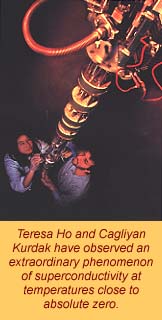PUTTING THEORIES
TO THE TEST
by Lynn Yarris

For the better part of 75 years, superconductivity was a curiosity that occurred only at temperatures close to absolute zero. The phenomenon was discovered by Heike Kamerlingh Onnes at the University of Leiden in 1911 when he used liquid helium to cool a sample of mercury to 4 degrees Kelvin (-269 degrees Celsius). Working with a variety of metal alloys, scientists, by 1973, had managed to raise the superconducting transition temperature of their best materials only to 23 Kelvins (-250 degrees Celsius). Then came the discovery of the so-called high-temperature superconductors in 1986 (see main story), and suddenly the dream of room-temperature superconductivity seemed more than mere fantasy.
If room-temperature superconductivity is ever to be achieved, the day might come sooner if scientists can learn more about the physics underlying high-Tc superconductors. It is widely accepted that classic low-temperature superconductivity was explained in 1957 by John Bardeen, Leon Cooper, and Robert Schrieffer, for which they won the 1972 Nobel Prize in physics. The BCS theory (named for the men who framed it) holds that the loss of electrical resistance in classic superconductors is the result of electron "pairing." In an ordinary metal, electrical resistance arises when the electrons carrying a current collide with imperfections as they pass through the atomic lattice. Such collisions deflect the electrons, impeding the flow of current and generating resistance. Paired electrons don't touch, but are connected in the sense that any movement by one is matched by an equal and opposite movement by the other. As a result of this mutual interaction, paired electrons do not generate electrical resistance.
There is much debate as to what extent BCS theory can be applied to high-Tc superconductivity. It is clear that the new ceramic superconductors involve some sort of electron pairing mechanism, but the nature of this mechanism is anyone's guess."When you've got a situation where there are more theories than theorists, you know you don't have an explanation," says Berkeley Lab physicist John Clarke. He and members of his research group have undertaken fundamental studies to find some of the answers that will help theorists come up with the missing explanation.
In one study, Konstantin Kouznetsov, Beth Chen, and Safi Bahcall, along with Clarke and the groups of UC San Diego Chancellor Robert Dynes and Donald Ginsberg at the University of Illinois, are examining the symmetry of the high-Tc electron pairs.
Explains Clarke, "In both low-Tc and high-Tc superconductors, the net spin of each electron pair is zero. Since electrons are fermions, this means that the angular momentum of each pair must have a symmetric wave function -- by analogy with the hydrogen atom, s-wave or d-wave, for example."
Electron pairing in classic low-Tc superconductors is mediated by phonons -- a vibration in the ions that form the lattice (sort of like an atomic soundwave) -- and the symmetry is s-wave. It has been proposed that the high-Tc pairing mechanism might be mediated not by phonons but by spin fluctuations -- distortions of the magnetic spins of the atomic lattice. If this were true, then the symmetry could be d-wave.
Clarke and his collaborators have been using the known s-wave symmetry in low-Tc superconductors to determine the symmetry of high-Tc superconductors. Using the two types of superconductors to form a Josephson junction through which a supercurrent is passed, they have made measurements that give evidence for high-Tc superconductors predominantly having d-wave pairing symmetry. A pairing mechanism cannot be determined from its symmetry alone, but this experiment supports the spin fluctuation theory while eliminating some of its competitors.
Says Chen, "Our results tell us that we should at least move away from the idea of a phonon-mediated pairing mechanism in high-Tc superconductors."
In research involving Clarke group members Cagliyan Kurdak, Alex Rimberg, and Teresa Ho, an extraordinary phenomenon was discovered on the 20 millikelvin temperature scale. On an electrically isolated ground plane consisting of a two-dimensional electron gas in a gallium arsenate substrate, the researchers deposited an array of 1600 superconducting islands made from aluminum, each coupled to its nearest neighbor by a Josephson junction measuring 70 nanometers by 70 nanometers. The array serves as a model of a granular superconductor that can be used to study the superconductor-insulator phase transition.
When the researchers increased the electrical resistance of the ground plane in a controlled way, they observed that the array made a phase transition from a superconductor to an insulator. This is the first time anyone has observed such a transition by changing the electromagnetic environment.
Says Kurdak, "It is as though you took two electrically isolated wires and changed the resistance of one of the wires by partially depleting its electrons. The other wire, which you haven't touched, is affected by this change even more strongly. This is mindblowing. We don't know of anything like this happening in either super- or semiconductors."
Theorists have already begun to come forward with explanations.
 RETURN TO TABLE OF CONTENTS
RETURN TO TABLE OF CONTENTS